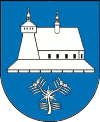Haczów
| Haczów | ||
|---|---|---|

|
|
|
| Basic data | ||
| State : | Poland | |
| Voivodeship : | Subcarpathian | |
| Powiat : | Brzozowski | |
| Gmina : | Haczów | |
| Area : | 25.00 km² | |
| Geographic location : | 49 ° 40 ' N , 21 ° 54' E | |
| Height : | 284 m npm | |
| Residents : | 3370 (Dec. 31, 2004) | |
| Postal code : | 36-213 | |
| Telephone code : | (+48) 13 | |
| License plate : | RBR | |
| Economy and Transport | ||
| Next international airport : | Rzeszów | |
Haczów is a village in southeastern Poland on the Wisłok in the Subcarpathian Mountains , 17 km southeast of Krosno . It is the seat of the rural community Haczów in the Powiat Brzozowski of the Subcarpathian Voivodeship .
history
In 1344, King Casimir III took over. the Great († 1370) the western edge of Red Ruthenia around Krosno . Before his death, the king granted the founding privilege of the village, which was first mentioned in 1388 as Hoczow . In addition, the local brook Morbach (now Morawa or Tabor) was mentioned, which indicated settlers of German origin. Other 19th century sources speak of villa, colonia teutonica. Hatshof, vel Hanshoff , which would be the original name of the village. The village was later mentioned as Oczow, Hoczow (1419), Hoczaw (1423), Hoczowo (1424), Hoczczw (1432), Hotczow (1433), Hocze (1440) and Haczow 1481.
It belonged to the Sanok country , Ruthenian Voivodeship . As can be seen from old church registers, the German language was probably preserved in the population until 1604. In 1624 Haczów was devastated by the Tatars . From 1772 to 1914 Haczów was part of the Sanok district and tax district in the Austrian province of Galicia . With the re-establishment of the Polish state in 1918 and the annexation of Galicia, the city became part of the Lviv Voivodeship in the powiat Brzozowski.
During the German occupation of Poland from 1939 to 1945, a Germanization campaign called “Hatschower” was used, according to which the residents were to be regarded as of German origin, but this failed due to resistance from those affected.
Population
The formerly very high German proportion of the population is particularly evident in the church records. So 1432-1440 dive with
Benner (Bonar), Dressler (Dreslar), Weiss (Weys, Weisz), Schulzenhayn, Eschenrath, Nickel (Nikiel), Weissgerber (Weisgirb), Scholz (Solcz). Flossnitzer, Schweingreber, Grebestetter, Gerlach (Gierlach, Gierloch), Glockenbrecht, Hansel, Sauhaar, Zöckler, Grob, Niebel
and 1523 with
Keller (Kyellar, Kielar / Kielur), Springler (Szprynglar), Krauss (Krausz), Meierth, Haechsler, Ross, Strampe, Paetzhold, Kolb, Rosenberg (Rozenbark, Rozembark), Rautenkranz, Schindler (Szyndlar), Struner, Polnar (Pojnar ), Kassner, Regel, Heckerth (Ekiert), Matthorn, Rothbart, Szmyd, Scheiner, Reichel, Vlamann, Fakenday, Rumpel, Reiss, Schwarz, Schmidt, Büttner (Butnar / Bytnar) many German names.
local community
The rural community of Haczów with more than 9,000 inhabitants includes six other villages.
Attractions
- Late Gothic wooden church (14th century) in Haczów, since 2003 a UNESCO World Heritage Site along with other wooden churches in southern Poland .
Sons and daughters of the place
- Janusz Gołda (* 1948), writer
- Edward Rymar (* 1936), historian
- Jan Stapiński (1867–1946), journalist and politician
literature
- Zygmunt Jaślar: Haczów, niezwykła osada szwedzko - niemiecka. Jasło 1938. Pigeon Germanism
- Ernst Black . From the " Forest Germans " in Galicia. 1960. "Silesia" century BC III. Pp. 147-156.
- Wojciech Blajer. Comments on the state of research on the Enklawen of the medieval German settlement between Wisłoka and San . [in:] Późne średniowiecze w Karpatach polskich. red. Prof. Jan Gancarski . Krosno. 2007. ISBN 978-83-60545-57-7
Individual evidence
- ↑ a b Tomasz Jurek (editor): Słownik Historyczno-Geograficzny Ziem Polskich w Średniowieczu. Edycja elektroniczna .
- ↑ Wojciech Blajer: Comments on the state of research on the enclaves of medieval German settlement between Wisłoka and San. In: Późne średniowiecze w Karpatach polskich. red. Jan Gancarski. Krosno 2007, ISBN 978-83-60545-57-7 , p. 82.
- ↑ "Villa, colonia teutonica. Hatshof, vel Hanshoff a Casimiro Magnus Reg. Pol. Huc deducta. E previlegio nimirum Vladislai Jagiellonis ex anno 1388 locationem villae confirmate, patet, eam praedicto Casimiro Regni deberi." op.cit. [in:] Schematism Universi Venerabilis Cleri. Jasło . 1872


